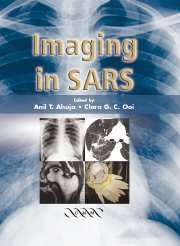Book contents
- Frontmatter
- Contents
- Contributors
- Preface
- 1 The Epidemiology of Severe Acute Respiratory Syndrome: A Global Perspective
- 2 The Role of Emergency Medicine in Screening SARS Patients
- 3 Severe Acute Respiratory Syndrome Outbreak in a University Hospital in Hong Kong
- 4 Imaging of Pneumonias
- 5 The Role of Chest Radiographs in the Diagnosis of SARS
- 6 Chest Radiography: Clinical Correlation and Its Role in the Management of Severe Acute Respiratory Syndrome
- 7 The Role of High-Resolution Computed Tomography in Diagnosis of SARS
- 8 The Role of Imaging in the Follow-up of SARS
- 9 Treatment of Severe Acute Respiratory Syndrome
- 10 SARS in the Intensive Care Unit
- 11 Imaging of Pneumonia in Children
- 12 Imaging and Clinical Management of Paediatric SARS
- 13 Imaging of SARS in North America
- 14 Radiographers' Perspective in the Outbreak of SARS
- 15 Implementation of Measures to Prevent the Spread of SARS in a Radiology Department
- 16 Aftermath of SARS
- 17 Update on Severe Acute Respiratory Syndrome
- Index
14 - Radiographers' Perspective in the Outbreak of SARS
Published online by Cambridge University Press: 27 October 2009
- Frontmatter
- Contents
- Contributors
- Preface
- 1 The Epidemiology of Severe Acute Respiratory Syndrome: A Global Perspective
- 2 The Role of Emergency Medicine in Screening SARS Patients
- 3 Severe Acute Respiratory Syndrome Outbreak in a University Hospital in Hong Kong
- 4 Imaging of Pneumonias
- 5 The Role of Chest Radiographs in the Diagnosis of SARS
- 6 Chest Radiography: Clinical Correlation and Its Role in the Management of Severe Acute Respiratory Syndrome
- 7 The Role of High-Resolution Computed Tomography in Diagnosis of SARS
- 8 The Role of Imaging in the Follow-up of SARS
- 9 Treatment of Severe Acute Respiratory Syndrome
- 10 SARS in the Intensive Care Unit
- 11 Imaging of Pneumonia in Children
- 12 Imaging and Clinical Management of Paediatric SARS
- 13 Imaging of SARS in North America
- 14 Radiographers' Perspective in the Outbreak of SARS
- 15 Implementation of Measures to Prevent the Spread of SARS in a Radiology Department
- 16 Aftermath of SARS
- 17 Update on Severe Acute Respiratory Syndrome
- Index
Summary
Introduction
Heath care workers are routinely exposed in a variety of diseases during their daily work. Although most health care workers would consider this as a part of their job, the general public is unaware of the risks taken by health care workers and the sacrifices they routinely make. The arrival of severe acute respiratory syndrome (SARS) changed that. Attention was focused on the health care workers since prior to SARS there was no precedent for an infectious disease that struck down hundreds of health care workers in a short period of time in a hospital setting. Hospitals were suddenly considered to be dangerous places to be in. As very little was known about this disease there was significant fear and anxiety among the hospital staff, and emotional disturbances in health care workers was inevitable.
During the SARS crisis, radiographers were indispensable in imaging patients for the diagnosis, management and follow-up of SARS patients. Similar to other medical staff, frontline radiographers needed to overcome their emotional stress and apprehension in order to deliver high-quality radiographic service to the SARS patients efficiently and safely. Radiographic practice had to be modified to minimize the risk of cross infection within the hospital and the radiology department. At short notice, radiographers at all levels of seniority had to familiarize themselves with infection control measures and the correct use of personal protective equipment within the radiology department, the hospital and other departments they served.
- Type
- Chapter
- Information
- Imaging in SARS , pp. 143 - 148Publisher: Cambridge University PressPrint publication year: 2004

